La Sportiva TX4

The TX4 is a well-made approach shoe, probably the most comfortable shoe I have worn. It performed well on my 60 miles of hiking local hills and in climbing at two local areas. It might be a bit narrow for those with wide feet.
The TX4 is best for people doing long approaches, including trail hiking and scrambling, along with moderate technical climbing.
Pros
- Very comfortable, excellent fit
- Very water repellent leather top
- Sticky rubber with good sole pattern
- Finger loop at heel makes putting shoe on easy
Cons
- Pricey
- Soft rubber will wear down rapidly, requiring re-sole
- Cord loops for laces make distributing foot-top pressure a bit of a challenge
- Color does not thrill me—personal taste, I guess
Background: At the top of the list of gear for anyone venturing into the woods and hills, whether a day hike, climbing, or backpacking is what you wear on your feet. In my many decades of outdoor activities, I have had footwear that ranged from miserable to wonderful. Much of that footwear has been single purpose, designed for a very narrow range of activities—specialized rock shoes and heavy boots for use on snow and ice with crampons or for skiing.
The specialized shoes for climbing are generally very uncomfortable to wear on an long approach trail. But the shoes we used to wear on the approaches often were not suitable for even simple scrambling. In recent years, with many approaches themselves covering remote and somewhat technical terrain, lighter weight shoes have been designed to deal with moderately technical terrain.
These approach shoes have seen some significant improvements, enabling their use on moderately technical climbs. Approach shoes have also made the exit hikes a lot more comfortable. They are light enough to clip to your harness or stick into a day pack when you change to your technical rock shoes or heavy double boots to be worn on glaciers or ice climbs.
A number of years ago, at the American Alpine Club’s Climbers Ranch in Jackson Hole, I arranged a climb of the Exum Direct with another climber. I expected to swap leads for the full length of the route and get a chance to rest my feet a bit on the descent, and so wore my rock shoes for the full climb. On the 3rd pitch, my partner informed me he was not up to leading his share of the pitches, leaving me to lead the remainder of the 2000 feet or so to the summit, including a couple of 5.9 detours to pass slower climbers. Because of some thunderclouds to the north, we descended fairly rapidly by the standard rappel route to our tent at the saddle, by which time my feet were really hurting in my rock shoes. I wanted to camp for the night, but my partner insisted he had to be back in Jackson. At least I had my hiking boots for the hike back to the car through the boulder field, mostly in the dark with fading batteries in my headlamp (my partner had dead batteries in his lamp).
I have certain expectations for any gear I am going to use. For approach shoes, I expect the following:
- Comfort when hiking and scrambling during approaches and exiting the area, this includes protection against rocks and pointy objects I step on
- Protection against sharp edges in jam cracks (same as for rock shoes)
- Light weight, both for hiking and for carrying when using specialized footwear
- Durability and long term usability
- Good grip on a wide range of surfaces at a range of inclinations—granite, limestone, sandstone, quartzite—wet and dry
- Flexibility for smearing
- Support for edging
- Water resistance for rainy conditions and stream crossings
First Impressions: I had just arrived home from our expedition to Japan and Mongolia (trip report at https://www.trailspace.com/forums/trip-reports/topics/171028.html) when the doorbell rang. I opened the door and the FedEx guy handed me a box with a pair of La Sportiva TX4 approach shoes, Euro size 42 (US size 9) in it. Since I was just off the plane after crossing the International Date Line from West to East in a 5664 mile, 10.5 hour flight, I put off opening the box until I could get a good night’s sleep.
The next morning, I opened the box to find the “papaya and yellow” colored TX4 shoes (that is what the description in the box says the color is). The design of the shoe is very similar to the La Sportiva Boulder and Boulder X approach shoes I have used over the past 10-12 years, both having a leather top like the TX4. I have re-soled the Boulder at The Rubber Room in Bishop, Calif. My more recent Boulder X has some stitching that has worn through from rubbing in jam cracks.
The TX4 is one of a family of TX shoes (TX2, TX3, TX4) with the Vibram MegaGrip Traverse outsole.
I quickly put on a pair of hiking socks and put the shoes on. I was delighted by the very comfortable fit, almost like they have been custom made for me. I will have to say, though, that the color scheme does not thrill me. But then, the last couple of running shoes I have bought from companies whose shoes fit me well are offered now only in colors that also do not thrill me.
OTOH, it only takes a little hiking on the dusty trails we have during the current drought to conceal the brightness of the color scheme. The photo was taken after a 10-mile, 2300 foot altitude gain “approach” hiking one of the local hills.
The shoes weigh 1p10.5oz/754 gm for the pair. The suggested price is $135. The shoe is to be in stores Spring 2016.
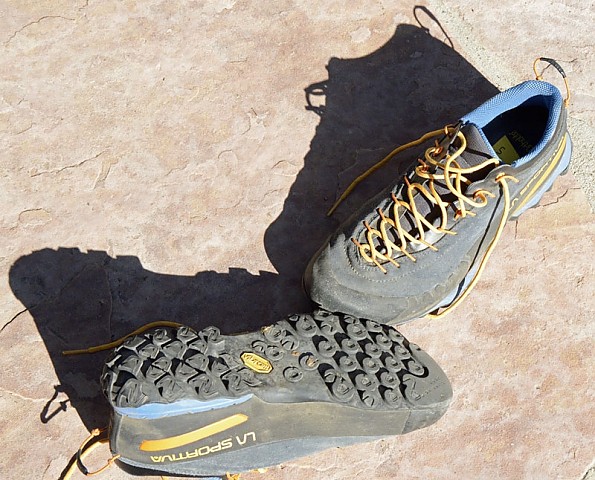
The TX4 after a couple hikes on dusty mountain trails
The shoe bottom of “sticky rubber”, made by Vibram, has numerous small round “cleats” with a depression in the middle of each “cleat” (bit of trivia – Vibram is the name of the company formed by Vitale Bramani in 1935 to manufacture boot soles for climbing boots, with the rubber lugs being shaped much like the nails used on climbing boots of the time).
I noted that the TX4 has a slight heel (about 1 cm high), with a gap under the arch where there are no “cleats”. On all my other approach shoes, the full sole is flat. The only advantage I can envision is that the resultant gap on the TX4 might stay in place better in an etrier.
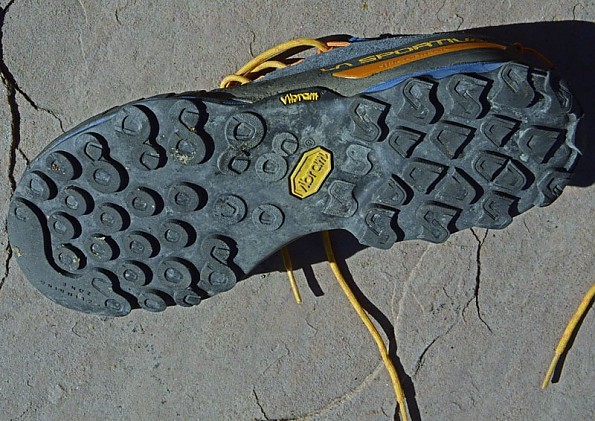
The sticky rubber sole - note the pattern difference of lugs between front and heel, with the heel slightly raised

Note that on the toe section of the sole in the photo, is a label that indicates where the smooth “Climbing Zone” is located.
In walking around our house and on stairs in some locations the pattern on the main sole area provided very good grip.
In the photo below, note the loop on the heel. This serves two purposes. First is the obvious aid to pulling the shoe on. Less obvious is that when you pull hard on the loop, you tighten the “tech” cord that reinforces the lacing loops (my guess is that it is Dyneema or a similar synthetic).
Done correctly, this is intended to help stiffen the sole for edging and help in smearing on the “Climbing Zone” along with reducing the amount of sliding of your foot inside the shoe. I would have liked better tightening of the laces toward the toes for climbing, though the TX4 still performed well on climbs.
Details of testing: I put on a pair of Injinji toe socks (what I use these days either as a liner or by itself for hiking, climbing, or long walks) and put the shoes on. Usually, I replace the original insole in any new boots with Superfeet. As mentioned above, the TX4's fit perfectly, with the supplied liners providing the right amount of support. It wasn’t really a surprise, though, since I have found over the years that boots by the Italian makers, La Sportiva and Scarpa, usually fit me well enough so I can buy them pretty much by size. This has been true for ski boots (downhill and telemark) and expedition (single and double, as well as the Olympus Mons).
The “last” that these companies use is close enough to my foot for comfort (the “last” is the foot-shaped block that a boot or shoe is designed and built around by the manufacturer for each size). There are boots from other companies that have excellent reputations that just plain do not fit me, even though the nominal size and width is my measured foot. It is important when fitting any footwear to find which companies use a last close to your foot shape.
I also did a bit of pulling on the heel loop, and did find some effect in stiffening the sole. It remains an approach shoe and is not a substitute for a dedicated rock shoe. Still, it worked well for scrambling on approaches.
My intention was to put at least 100 miles of “approach” on the shoes, plus do a few climbs at a couple of climbing areas. Here in California, we are blessed with a wide variety of rock types within a short distance, plus plenty of hiking trails. As it turned out, a large number of tasks were waiting for my attention, one of which was sorting out my health care program. Other demands on my time were (and are) supporting several charitable causes since I “retired”, plus writing the trip report for our Asia expedition.
Despite those demands, I managed to do a number of hikes in the local hills, ranging from 6 miles to 15 miles in length, with altitude gains of 1500 to 2300 feet of elevation gain (and loss on returning to the car). I also wore the TX4's for walking to the local grocery store, pizza parlor, and sandwich shop (about 4 miles for each). I also made treks to our closest well-known climbing areas at Pinnacles National Park and Castle Rock State Park (well-known for producing a number of well-known climbers).
The following photos show the positioning of the TX4's on various slopes to give an idea of the gripiness of the shoes. I was well pleased with the performance both on the volcanic conglomerate at Pinnacles NP and on the sandstone at Castle Rock SP.
Castle Rock is very close to being on the San Andreas. The rock there is coastal sandstone. This means that during dry spells, some sections of rock are well cemented, while others are very friable, and brushing the surface with your hand or shoe scrapes off sand particles. Climbing at Castle Rock is forbidden during rain and for a minimum of 3 days after the rain stops. The climbing is mostly bouldering, and in most of the park is very enjoyable. The following are on various formations in the park.
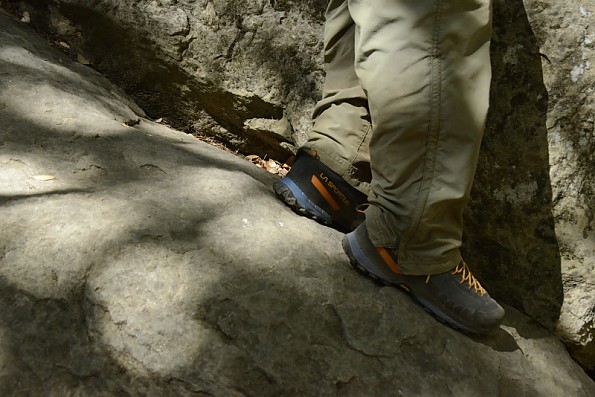
Comfortable grip when down-climbing
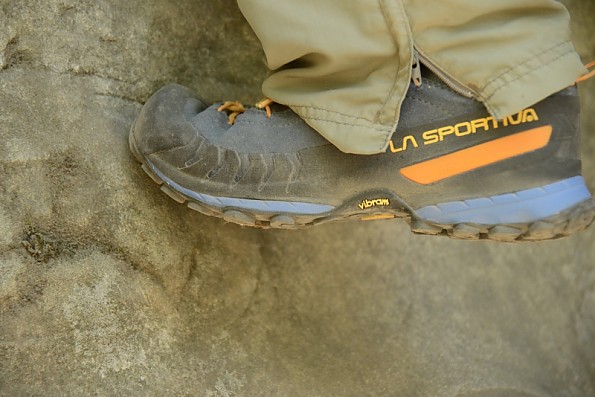
Good grip when smearing on sandstone
Pinnacles National Park sits directly on the San Andreas Fault Rift. The rock is a volcanic conglomerate with pieces of a wide variety of minerals embedded in the solidified magma. Some of the minerals are in the form of large crystals that would provide large steps, if the crystals were not highly polished slopers and did not from time to time simply lift out in your hand, plus being located in widely spaced random patterns. In some places the climbing requires long reaches and/or big steps.
The video is on a formation named the Sisters, in particular on First Sister. There were other climbers doing routes just around the rock a short distance, and it is their voices you are hearing, as well as some commentary between them and me. The routes are run-out in many places, so I was providing them some hints on where the bolts were located.
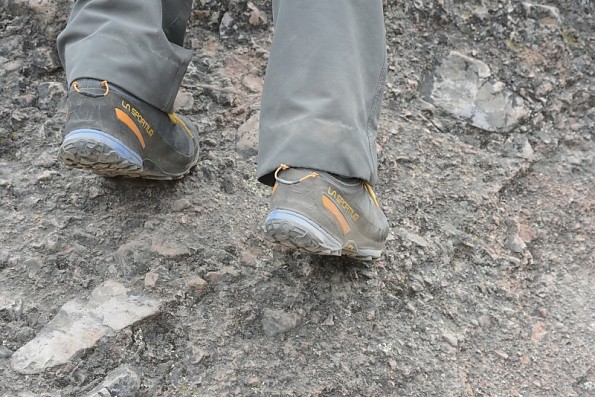
The big inclusions in the Pinnacles volcanic conglomerate tend to be slick, so step between them

Excellent grip on the gritty sections of the volcanic conglomerate
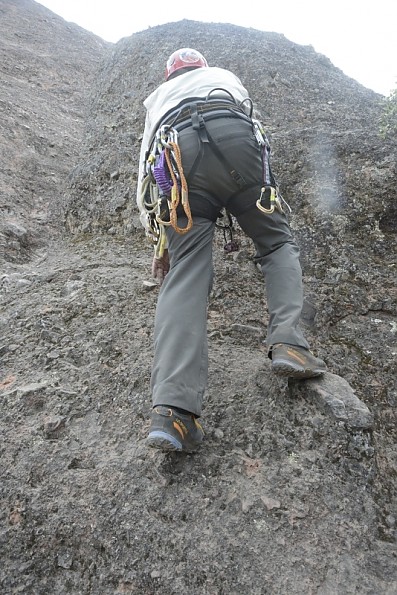
The “Climbing Zone” worked well on the slick inclusions
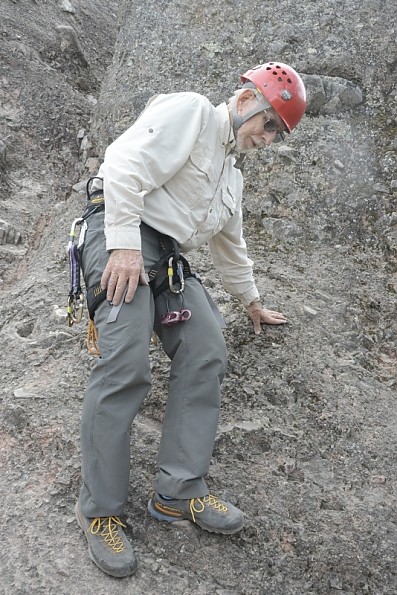
Descending while facing out provided comfortable grip
Note in the video that during the ascent, you are seeing the bottom of my shoe most of the time. This shows that the “Climbing Zone” at the toe of the shoes, as seen in one of the photos, is providing the grip by smearing.
Conclusions: The La Sportiva TX4 approach shoe meet all my listed expectations for an approach shoe. So I gave the shoe a full 5-star rating. Although I did not reach my intended hundred miles of approach, I did accumulate about 60 miles. Most of this was on dusty trails, though some included rocky sections and a bit of scrambling.
I can not completely comment on the “break-in” part of requirement 4 (durability and long-term usability), since I did not do a full 100 miles. The sole appears to be wearing well for a sticky rubber. We did get a little rain, during which I can say that my feet remained dry (as you would expect for a leather upper). The leather upper also keeps the dust out, unlike mesh uppers.
Keep in mind that everyone’s feet differ. So while the TX4 fit me perfectly, so it might not fit people with a wide foot as well. Most approach shoes have a low top. I find this preferable for me, since many of my approaches and exits require placing the sole flat on the rock, hence angling the ankles. Since I have climbed for many years on slabs and using crampons on inclined ice, I am fine with this. However, some people might prefer an approach shoe with a mid to high ankle for ankle support.
The TX4 climbed very well on the sandstone of Castle Rock and on the volcanic conglomerate of Pinnacles. While I did not get a chance to climb on quartzite or limestone during the review period, we have a quartzite floor at two of the doors of our house, so I was able to do a bit of foot-scuffing to check the grip on quartzite, where it did well.
Source: received for testing via the Trailspace Review Corps
(Sample provided by La Sportiva for testing and review)
Your Review
Where to Buy
You May Like
Specs
| Men's | |
|---|---|
| Price |
MSRP: $135.00 Current Retail: $105.81-$159.00 Historic Range: $89.00-$159.00 |
| Women's | |
|---|---|
| Price |
Current Retail: $78.83-$159.00 Historic Range: $78.83-$159.00 |





